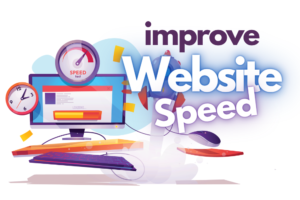
Every single second matters when it comes to website speed.
If you’re not convinced yet, think about your own browsing habits. How often have you found yourself checking out a site only to hit the ‘back’ button when it takes more than a few seconds to load?
Generally speaking, everyone else browses the web in the same manner. If you’re not delivering that great content fast enough, you could lose out on massive traffic. And as we all know, traffic translates to ad revenue.
You could be losing out on potential money. But don’t fret, we can help! We’ve come up with some great tips to help you improve your website speed. Read on to see how you can make your site the best.
How you can improve website speed
Check your page load speed

One second is all it takes for a user to decide that your website isn’t worth their time. It’s finicky, perhaps, but it’s also a fact.
That’s why you’ll need to do some quick inventory of your site to see how quickly your web pages load. If you’ve got a Google Analytics account, you can get access to this info for free.
Once you’ve established how long it takes to reach your homepage, test out every other page on your site. This may sound tedious, but it’ll be more than worth it in the long run.
If your landing page includes a pop-up, such as a listing for your email listing, you’ll also want to see how long it takes before the ad pops up. Having it appear too soon or too late makes a massive difference. Shoot for between 2-4 seconds after users enter your site.
Make sure you’ve got a well-optimized mobile site
Step two on the path to digital success is ensuring your website can be easily accessed via a mobile browser.
Thankfully, Google has made things easy, and you can use the same speed test tool you used for your desktop site.
Mobile pages can be tricky, as users may run into a redirect that will slow down their access to your page. In short, you’ll want to do everything within your power to ensure this doesn’t happen. Mobile redirects can be your worst nightmare, so do everything you can to establish parity between your mobile and desktop sites.
Optimize your homepage

Before you read on, take a moment to evaluate your homepage. What information does it include?
How are the menus organized? Are there perhaps too many or too few images?
You may be thinking to yourself “This is an awful lot of preparation,” and you’d be correct.
But how can you know where to go if you haven’t properly evaluated where you are?
Now it’s time to set some goals. Here’s where your own experience as a web user comes in handy. When visiting a website, what are the first things you look for? Take that information and translate it to your site.
If the most important information isn’t listed, how can you expect customers to care? Ensure that your homepage has contact information, as well as an effective call-to-action to get users interested enough to venture beyond your initial page.
Consider your site from the perspective of someone planning on spending no more than 20 to 30 seconds on it. Can they successfully gather all the information you’d want them to have?
Make sure to take advantage of our free SEO audit to make sure your copy is properly optimized for SEO, as well!
Even the font you’re using matters.
Optimize your images
Now you’re going to need to take stock of the images on your website — particularly your homepage. How many images are there? Is every single image 100% necessary? If not, remove the clutter to improve website speed.
Yahoo! has some great tips on the best practices for imaging, so be sure to read up on their suggestions! Their post suggests utilizing CSS, but JPG files are the most common graphical form used on the web and are a great solution if you’re serving as your own webmaster.
JPGs are great because generally speaking, they’re a relatively small file size, meaning images will load faster, and your user will have a more seamless experience. You’ll have to sacrifice some image sharpness, as JPGs aren’t as high quality as PNGs, but it’s ultimately a worthwhile trade.
Visit your competitors’ pages
Now for the fun part: time to do some sleuthing and see what your competitors are up to!
Create a list of two or three of your top competitors and use Google Analytics to see how quickly their pages are loading. How does it compare to your site? If their pages are loading faster than yours, you’ve got a problem.
Take the tips we’ve given and implement them on your site, prioritizing your homepage.
We can help!
There’s no need to panic if you need to improve website speed, we’re here to help you create your best site possible!
We offer an abundance of web services that run the gamut from link building and content management to SEO auditing and mobile marketing.
We want to be your digital agency of choice in Europe, so let us show you why we’re the best at what we do.
Get in touch with us today to utilize our fantastic services, and follow us on Facebook and Twitter for hot tips and tricks for digital marketing.

 Choosing the Right Video Marketing Services for You
Choosing the Right Video Marketing Services for You
Leave a Reply